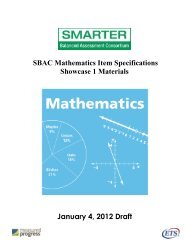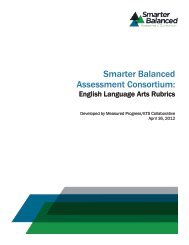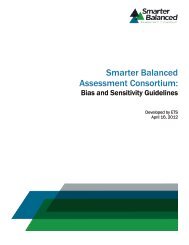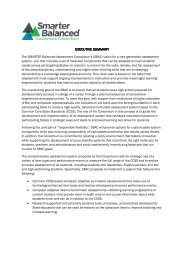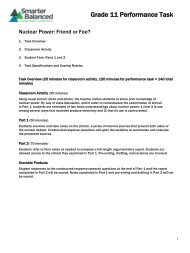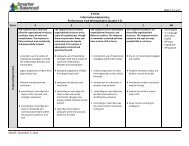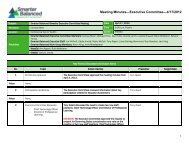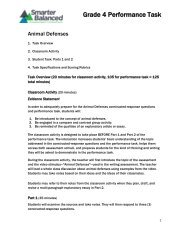Content Specifications for the Summative Assessment of the ...
Content Specifications for the Summative Assessment of the ...
Content Specifications for the Summative Assessment of the ...
Create successful ePaper yourself
Turn your PDF publications into a flip-book with our unique Google optimized e-Paper software.
To <strong>the</strong> degree possible, all in<strong>for</strong>mational passages will include at least one item assessing each <strong>of</strong> <strong>the</strong> 4<br />
assessment targets (#8-#11) below.<br />
SUPPORTING EVIDENCE: Cite specific RI-1 Cite <strong>the</strong> textual evidence that most strongly supports an analysis <strong>of</strong> what <strong>the</strong> text<br />
textual evidence to support conclusions drawn says explicitly as well as inferences drawn from <strong>the</strong> text.<br />
from <strong>the</strong> text(s)<br />
RH-1 Cite specific textual evidence to support analysis <strong>of</strong> primary and secondary<br />
Standards: RI-1, RH-1, RST-1<br />
sources.<br />
(RI-1 is a component <strong>of</strong> each <strong>of</strong> <strong>the</strong> seven<br />
targets listed below.)<br />
RST-1 Cite specific textual evidence to support analysis <strong>of</strong> science and technical texts.<br />
8. KEY DETAILS: Identify explicit text<br />
evidence to support inferences made or<br />
conclusions drawn about texts<br />
Standards: RI-1, RH-1, RST-1, RI-3, RH-3<br />
(DOK 2)<br />
9. CENTRAL IDEAS: Summarize central<br />
ideas, topics/subtopics, key events, or<br />
procedures using supporting ideas and details<br />
Standards: RI-2, RH-2, RST-2<br />
(DOK 2)<br />
RI-1 Cite <strong>the</strong> textual evidence that most strongly supports an analysis <strong>of</strong> what <strong>the</strong> text<br />
says explicitly as well as inferences drawn from <strong>the</strong> text.<br />
RH-1 Cite specific textual evidence to support analysis <strong>of</strong> primary and secondary<br />
sources.<br />
RST-1 Cite specific textual evidence to support analysis <strong>of</strong> science and technical texts.<br />
RI-3 Analyze how a text makes connections among and distinctions between<br />
individuals, ideas, or events (e.g., through comparisons, analogies, or categories).<br />
RH-3 Identify key steps in a text’s description <strong>of</strong> a process related to history/social<br />
studies (e.g., how a bill becomes law, how interest rates are raised or lowered).<br />
RI-2 Determine a central idea <strong>of</strong> a text and analyze its development over <strong>the</strong> course <strong>of</strong><br />
<strong>the</strong> text, including its relationship to supporting ideas; provide an objective summary <strong>of</strong><br />
<strong>the</strong> text.<br />
RH-2 Determine <strong>the</strong> central ideas or in<strong>for</strong>mation <strong>of</strong> a primary or secondary source;<br />
provide an accurate summary <strong>of</strong> <strong>the</strong> source distinct from prior knowledge or opinions.<br />
RST-2 Determine <strong>the</strong> central ideas or conclusions <strong>of</strong> a text; provide an accurate summary<br />
<strong>of</strong> <strong>the</strong> text distinct from prior knowledge or opinions.<br />
10. WORD MEANINGS: Determine RI-4 Determine <strong>the</strong> meaning <strong>of</strong> words and phrases as <strong>the</strong>y are used in a text, including<br />
intended or precise meanings <strong>of</strong> words,<br />
figurative, connotative, and technical meanings; analyze <strong>the</strong> impact <strong>of</strong> specific word<br />
including domain-specific (tier 3) words and choices on meaning and tone, including analogies or allusions to o<strong>the</strong>r texts.<br />
words with multiple meanings (academic/tier 2 RH-4 Determine <strong>the</strong> meaning <strong>of</strong> words and phrases as <strong>the</strong>y are used in a text, including<br />
words), based on context, word relationships, vocabulary specific to domains related to history/social studies.<br />
word structure (e.g., common Greek or Latin RST-4 Determine <strong>the</strong> meaning <strong>of</strong> symbols, key terms, and o<strong>the</strong>r domain-specific words<br />
roots, affixes), or use <strong>of</strong> resources (e.g., and phrases as <strong>the</strong>y are used in a specific scientific or technical context relevant to grades 6–8<br />
dictionary, glossary)<br />
texts and topics.<br />
Standards: RI-4, RH-4, RST-4; L-4, L-5b, L-4 Determine or clarify <strong>the</strong> meaning <strong>of</strong> unknown and multiple‐meaning words or<br />
L-5c, L-6<br />
phrases based on grade8 reading and content, choosing flexibly from a range <strong>of</strong> strategies.<br />
(DOK 1, DOK 2)<br />
a. Use context (e.g., <strong>the</strong> overall meaning <strong>of</strong> a sentence or paragraph; a word’s position or<br />
function in a sentence) as a clue to <strong>the</strong> meaning <strong>of</strong> a word or phrase.<br />
b. Use common, grade‐appropriate Greek or Latin affixes and roots as clues to <strong>the</strong><br />
meaning <strong>of</strong> a word (e.g., precede, recede, secede).<br />
c. Consult general and specialized reference materials (e.g., dictionaries, glossaries,<br />
<strong>the</strong>sauruses), both print and digital, to find <strong>the</strong> pronunciation <strong>of</strong> a word or determine or<br />
clarify its precise meaning or its part <strong>of</strong> speech.<br />
d. Verify <strong>the</strong> preliminary determination <strong>of</strong> <strong>the</strong> meaning <strong>of</strong> a word or phrase (e.g., by<br />
checking <strong>the</strong> inferred meaning in context or in a dictionary).<br />
L-5b Use <strong>the</strong> relationship between particular words to better understand each <strong>of</strong> <strong>the</strong><br />
words.<br />
L-5c Distinguish among <strong>the</strong> connotations (associations) <strong>of</strong> words with similar<br />
denotations (definitions) (e.g., bullheaded, willful, firm, persistent, resolute).<br />
L-6 Acquire and use accurately grade‐appropriate general academic and domainspecific<br />
words and phrases; ga<strong>the</strong>r vocabulary knowledge when considering a word or<br />
phrase important to comprehension or expression.<br />
Use <strong>the</strong> specific text (or two or more texts) to determine two additional assessment targets (#12, #13, or #14)<br />
to be assessed in relation to <strong>the</strong> text(s).<br />
11. REASONING & EVALUATION:<br />
Apply reasoning and a range <strong>of</strong> textual<br />
evidence to justify inferences or interpret<br />
author’s presentation <strong>of</strong> in<strong>for</strong>mation (author’s<br />
line <strong>of</strong> reasoning, point <strong>of</strong> view/purpose<br />
support claims, concepts, ideas; relevance <strong>of</strong><br />
evidence or elaboration to support claims)<br />
Standards: RI-6, RH-6, RST-6, RI-8, RH-8,<br />
RST-8<br />
RI-6<br />
Determine an author’s point <strong>of</strong> view or purpose in a text and analyze how <strong>the</strong><br />
author acknowledges and responds to conflicting evidence or viewpoints.<br />
RH-6 Identify aspects <strong>of</strong> a text that reveal an author’s point <strong>of</strong> view or purpose (e.g.,<br />
loaded language, inclusion or avoidance <strong>of</strong> particular facts).<br />
RST-6 Analyze <strong>the</strong> author’s purpose in providing an explanation, describing a procedure, or<br />
discussing an experiment in a text, identifying important issues that remain unresolved.<br />
RI-8 Delineate and evaluate <strong>the</strong> argument and specific claims in a text, assessing<br />
whe<strong>the</strong>r <strong>the</strong> reasoning is sound and <strong>the</strong> evidence is relevant and sufficient; recognize<br />
when irrelevant evidence is introduced.<br />
36



